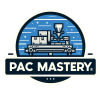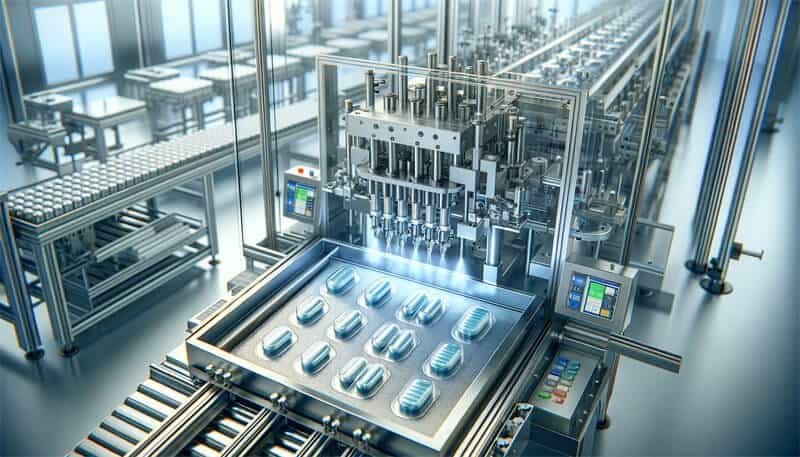At PacMastery, our mission is to revolutionize the packing machinery industry through innovative solutions, unparalleled quality, and relentless dedication to customer satisfaction. We strive to empower businesses around the globe with cutting-edge technology and customized machinery, ensuring efficiency, reliability, and excellence in every packaging process. Committed to sustainability and ethical practices, we are not just building machines; we’re crafting a more efficient, productive, and responsible future in packaging.
Key Takeaways
| Question | Answer |
|---|---|
| What is a blister packing machine? | A blister packing machine is a device that seals products in a cavity, usually made of plastic or aluminum, creating a blister pack. |
| How does the blister packing process work? | The process includes forming the blister, filling it with the product, sealing it, and cutting it into individual packs. |
| What are the benefits of using blister packing machines? | Benefits include product protection, tamper evidence, cost efficiency, and enhanced product presentation. |
| What industries use blister packing machines? | Common industries include pharmaceuticals, food and beverage, and consumer electronics. |
| How do blister packing machines compare to other packaging methods? | Blister packing offers unique advantages in product protection and presentation, making it ideal for certain applications. |
| What common questions do users have about blister packing machines? | Users often ask about materials used, machine maintenance, and troubleshooting common issues. |
What is a Blister Packing Machine?
A blister packing machine is a specialized device used to package products in a pre-formed plastic or aluminum blister. These machines are integral to industries that require secure and visually appealing packaging, such as pharmaceuticals, food and beverages, and consumer electronics. At its core, a blister packing machine creates a cavity, or pocket, in which the product is placed. The cavity is then sealed with a lidding material, typically aluminum foil, creating a blister pack that protects the product from environmental factors and tampering.
The Blister Packing Process
The blister packing process involves several key steps to ensure the product is securely enclosed within the blister pack. Here is a detailed breakdown of each step:
Forming the Blister
- Material Heating: The packaging material, often plastic, is heated until it becomes pliable.
- Blister Forming: The heated material is then molded into the desired shape using a forming die.
Filling the Blister
- Product Placement: Once the blister is formed, the product is placed into the cavity, either manually or through an automated system.
Sealing the Blister
- Lidding Material: A piece of lidding material, typically aluminum foil, is placed over the filled blister.
- Heat Sealing: The lidding material is sealed to the blister using heat and pressure, ensuring an airtight seal.
Cutting the Blister Packs
- Pack Separation: The sealed blisters are cut into individual packs, which are then ready for distribution and sale.
Types of Blister Packing Machines
Blister packing machines come in various types, each suited to specific applications and production requirements. The main types include:
- Rotary Blister Packing Machines: Ideal for high-speed production with continuous motion.
- Flat Bed Blister Packing Machines: Suitable for smaller batches and more versatile applications.
Pros and Cons of Each Type
| Type | Pros | Cons |
|---|---|---|
| Rotary | High speed, continuous operation | Higher initial cost, complex setup |
| Flat Bed | Flexibility, easier setup | Slower production speed, suitable for smaller batches |
Benefits of Using Blister Packing Machines
Blister packing machines offer numerous advantages that make them a preferred choice for many industries. These benefits include:
- Efficiency: Streamlined packaging process that increases production speed.
- Product Protection: Ensures products are shielded from environmental factors and tampering.
- Cost-Effectiveness: Reduces packaging material waste and lowers overall packaging costs.
- Enhanced Presentation: Improves product display and branding opportunities.
Key Benefits
- Efficiency and Speed: Blister packing machines can handle high volumes of products quickly and efficiently.
- Product Safety: Blister packs provide a secure and tamper-evident packaging solution.
- Cost Savings: By optimizing material usage, these machines reduce packaging costs.
- Branding and Presentation: Blister packs enhance product visibility and appeal on store shelves.
Industry Applications
Blister packing machines are versatile and find applications in a variety of industries. Some of the most common uses include:
Pharmaceutical Industry
- Medicine Packaging: Ensures tablets and capsules are protected and easy to dispense.
- Compliance Packaging: Helps patients adhere to medication schedules with pre-measured doses.
Food and Beverage Industry
- Snack Packaging: Keeps products fresh and extends shelf life.
- Sample Packs: Offers a convenient way to distribute product samples.
Consumer Electronics
- Accessory Packaging: Protects small electronic components and accessories.
- Retail Packaging: Enhances product display and provides tamper evidence.
Comparative Analysis: Blister Packing vs. Other Packaging Methods
When choosing a packaging method, it is essential to consider the specific needs of the product and the industry. Blister packing offers several unique advantages compared to other packaging methods:
Comparison with Other Methods
| Packaging Method | Advantages | Disadvantages |
|---|---|---|
| Blister Packing | Tamper evidence, product protection, clear display | Higher cost for small batches |
| Bottle Packaging | Easy to use, good for liquids | Bulky, more material usage |
| Sachet Packaging | Cost-effective, flexible sizes | Limited protection, not tamper-evident |
Frequently Asked Questions (FAQs)
Blister packing machines often raise several common questions from users. Here are some of the most frequently asked questions and their answers:
- What materials are used in blister packing?
- Common materials include PVC, PET, and aluminum foil.
- How do you maintain a blister packing machine?
- Regular cleaning, lubrication, and inspection of parts are essential for maintenance.
- What are common issues with blister packing machines?
- Common issues include misalignment, sealing failures, and material jams.
For more detailed information and expert insights, visit our Comprehensive Guide to Blister Packing Machines.
Expert Insights and Recommendations
To maximize the efficiency and effectiveness of blister packing machines, industry experts offer several valuable insights and recommendations. These include best practices for machine operation, tips for troubleshooting common issues, and strategies for optimizing the packaging process.
Best Practices for Machine Operation
- Regular Maintenance: Routine maintenance is crucial to ensure the longevity and optimal performance of blister packing machines. This includes cleaning, lubrication, and part replacement as needed.
- Operator Training: Proper training for machine operators can significantly reduce the risk of errors and improve the overall efficiency of the packaging process.
- Quality Control: Implementing strict quality control measures can help identify and address issues early, ensuring that only high-quality blister packs reach the market.
Tips for Troubleshooting Common Issues
- Sealing Failures: Ensure that the sealing temperature and pressure are correctly set according to the material specifications. Regularly check and clean the sealing components.
- Material Jams: Regularly inspect the material feed system and remove any obstructions. Ensure that the materials used are compatible with the machine.
- Misalignment: Properly calibrate the machine to ensure precise alignment of the blister cavities and the lidding material.
Optimizing the Packaging Process
- Material Selection: Choose materials that are suitable for the product being packaged and the specific requirements of the blister packing machine.
- Process Automation: Incorporate automation to streamline the packaging process, reduce manual intervention, and increase production speed.
- Sustainability: Consider using eco-friendly materials and practices to reduce the environmental impact of the packaging process.
Conclusion
Blister packing machines are a vital component of modern packaging solutions, offering numerous benefits in terms of efficiency, product protection, and presentation. At PacMastery, we are committed to providing innovative and high-quality blister packing machines that meet the diverse needs of our clients across various industries.
Whether you are in the pharmaceutical, food, and beverage, or consumer electronics industry, our advanced blister packing machines can help elevate your packaging processes, ensuring your products are securely and attractively packaged.
Explore our range of blister packing solutions and discover how PacMastery can help you achieve greater efficiency, reliability, and sustainability in your packaging operations.
For more information, visit our Comprehensive Guide to Blister Packing Machines or contact us today to discuss your specific needs.




2 Responses
Great blog! Is your theme custom made or did you download it from
somewhere? A theme like yours withh a few simple adjustements would
really make my blog jump out. Please llet me know where you got yolur design. Bless you https://Odessaforum.Biz.ua/
Great blog! Is your theme custom mae or ddid you download it from somewhere?
A theme like yours with a few simple adjustements would really
make my blog jump out. Please let mee know where you got your design.
Bless you https://Odessaforum.Biz.ua/